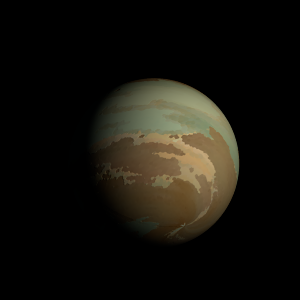|
|
Space Astro
|
Info for exoplanet "Pyonyoza"
| Scientific (actual) data |
|---|
| Name | Kepler-1461 b |
| Planet status | Confirmed |
| Radius | 0.181 |
| Orbital period | 29.3495 |
| Discovered | 2016 |
| Updated | 2021-02-05 |
| Tconj | 2454980 |
| Publication | Announced on a website |
| Detection type | Primary Transit |
| Alternate names | 2MASS J19031930+4311542 b, K03303.01, KIC 7510820 b, KOI-3303 b, KOI-3303.01, WISE J190319.31+431154.2 b |
| Star name | Kepler-1461 |
| Right ascension | 285.83° |
| Declination | 43.2° |
| Mag j | 14.137 |
| Mag h | 13.706 |
| Mag k | 13.471 |
| Star distance | 752 |
| Star metallicity | -0.04 |
| Star mass | 0.79 |
| Star radius | 0.74 |
| Star age | 3.24 |
| Star temperature | 4919 |
| Star alternate names | 2MASS J19031930+4311542, KIC 7510820, KOI-3303, WISE J190319.31+431154.2 |
| Wikipedia article | Kepler-1461 b |
Back
| |
| Fictional info (?) |
|---|
| Suggested name | Pyonyoza |
| Planet type | Cold planet |
| Having almost no atmosphere to retain heat, it has surface temperatures that vary diurnally more than on any other planet in its solar system, ranging from 150°K (-123°C) at night to 1015°K (742°C) during the day across the equatorial regions. |
| Atmosphere | Hydrogen deuteride (HD) | 98% |
| Sulfur dioxide | 0.76% |
| Ozone | 0.15% |
| Ammonia | 0.079% |
| Molecular hydrogen | 0.031% |
| Atmospheric pressure | 0.5 bar |
 |
| Moon | Waiukyo Se | Medium-sized almost round ice moon |
| Zopona-subomya | Small potato shaped oceanic moon |
| Zupipya Gemura | Very small almost round ice comet |
| Supura-rishu | Medium-sized irregular crater-filled planetoid |
| Chozaso | Small round rocky asteroid |
| Mizegu'se | Very small round oceanic planetoid |
| Worigyu | Very small almost round gaseous planetoid |
| Zehichi | Small potato shaped oceanic comet |
| Ryuayo-nyasho | Large round rocky moon |
| Gyopyo-ra | Medium-sized round crater-filled asteroid |
| Myoryo'ka | Medium-sized irregular oceanic moon |
| Gawago Gya | Large round rocky moon |
| Kobe Gupi | Very small slightly egg-shaped crater-filled asteroid |
| Dome | Very small slightly egg-shaped ice comet |
| Ganya | Very small irregular ice comet |
| Myukya | Medium-sized potato shaped rocky planetoid |
| Jimape | Very small almost round ice planetoid |
| Pogyoryo Yo | Huge round oceanic comet |
| Google search for Pyonyoza |
|
Website by Joachim Michaelis
|
|
|
|